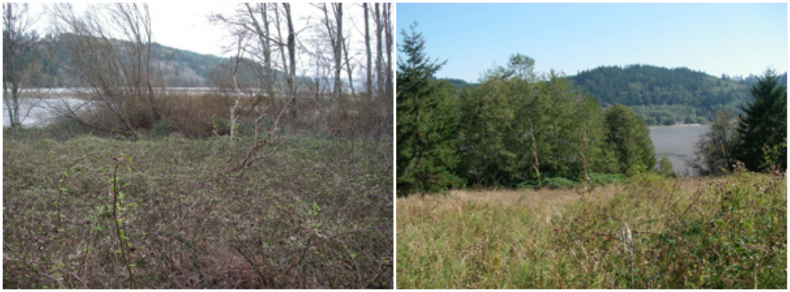Dabob Bay Natural Area

The Dabob Bay Natural Area was established in 1984 to protect rare examples of intact salt marsh and sand spit plant communities within one of Washington’s highest functioning coastal spit and tidal wetland systems. Initially created as a natural area preserve (NAP), the site was enlarged in 2009, and again in 2016, to include additional land designated as NAP, along with lands designated as natural resources conservation area (NRCA). This provides additional opportunities for low-impact public use.
The natural area includes mature coastal forests, coastal streams, feeder bluffs, forage fish spawning areas, eelgrass beds, native Olympia oyster beds, nearshore tidelands and mudflats utilized by juvenile salmon and shorebirds, and open marine waters utilized by salmon, marine birds, harbor seals and orcas. The combined NAP/NRCA currently comprises 3,294 acres of shoreline, marsh and forestland in the Dabob Bay watershed.
Features protected: North Pacific Maritime Coastal Sand Dune and Strand ecosystem, Temperate Pacific Tidal Salt and Brackish Marsh ecosystems, North Pacific Maritime Forest ecosystems, North Pacific Intertidal Mudflat ecosystem, North Pacific Maritime Eelgrass ecosystem.
Ecoregion: Puget Trough (Jefferson County)
Ecoregion: Puget Trough (Jefferson County)
Science, Research and Monitoring
Public and private universities, other research institutions and individual researchers may contact DNR to propose a research project at the site. If you are interested in pursuing research at Dabob Bay, please contact David Wilderman, Natural Areas Ecologist, at david.wilderman@dnr.wa.gov.
Examples of research and monitoring projects
- Bahls, P. 2004. Fish Distribution and Abundance in Shallow Intertidal Habitats of Tarboo and North Dabob Bays. Unpublished report prepared for Jefferson County Marine Resources Committee, Port Hadlock, WA. 21pp.
- Vegetation monitoring of salt marsh spit community
- Dabob Bay Vascular Plant Inventory (446KB PDF)
Environmental Education and Public Access
Currently there are no formal educational programs at Dabob. The site is not ADA accessible and facilities are not available. A future site-based management planning process will include participation from the scientific, educational, recreational and local communities. For more information, contact the DNR Olympic Region Natural Areas Manager.
Restoration at Dabob Bay Natural Area
Washington Wildlife and Recreation Program Restoration Project
Implementing a grant from the Washington State Recreation and Conservation Office, nine acres of degraded fields and disturbed riparian areas are being converted back to native habitat. This project is improving habitat and reestablishing connectivity between Tarboo Bay and the upland forest landscape by removing non-native invasive vegetation, installing coarse woody debris, and replanting the site with native trees and shrubs.

Before restoration work, disturbed areas were choked with weeds such as Himalayan blackberry and perennial pasture grasses that prevent native forest from re-establishing on the site.

In the course of restoration work, invasive species are removed and native forest species—as well as ecologically important large woody materials—are returned to formerly disturbed areas.


